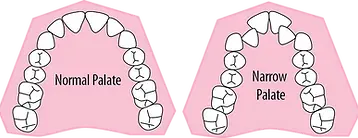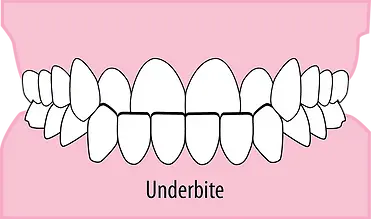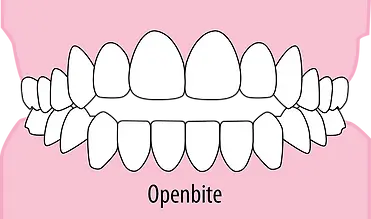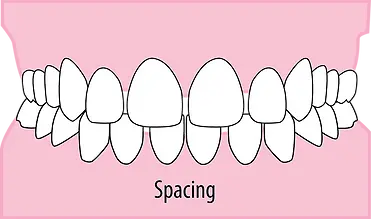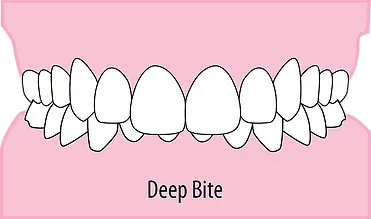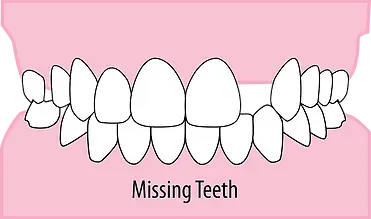Orthodontic Conditions
If you've delved into orthodontic treatment, you've likely encountered unfamiliar terms like crossbites, overbites, and tongue thrusts. Below are 8 of the most prevalent orthodontic issues we identify during consultations with patients of varying ages. These descriptions will clarify what Dr. Weiss diagnoses and will provide deeper insights into the conditions affecting your dental health.

Common Malocclusions
Crowding
Dental crowding occurs when there is not enough space for the teeth, causing them to rotate or shift out of alignment instead of aligning properly. It is a frequent concern raised during initial consultations. Addressing crowding not only enhances one's smile but also simplifies oral hygiene, particularly if there was overlapping of teeth initially. Braces or aligners are commonly used to correct crowding. In severe cases, a palatal expander may be necessary to create adequate space.
Narrow Palate
An undersized or narrow palate is a significant clinical condition that has garnered attention in discussions about breathing and the airway. When the palate is too small, it can lead to insufficient space for adult teeth as they grow in. Patients may experience difficulty breathing through their nose, develop a posterior crossbite (explained below), or find that their lower teeth tilt inward toward the tongue. A proven and effective treatment for a narrow palate is the use of a palatal expander. In more severe cases among adult patients, jaw surgery may be recommended as part of the optimal treatment options.
Posterior Crossbite
Ideally, the upper jaw should be wider than the lower jaw, allowing the top teeth to naturally overlap the lower teeth when biting down, much like a lid fitting snugly over a jar. A crossbite occurs when the upper teeth are positioned behind the lower teeth instead of over them. Dr. Weiss frequently observes that patients with a posterior crossbite (involving the back teeth) tend to shift their jaw left or right to find a comfortable chewing position. However, this habit can lead to asymmetrical jaw growth or other persistent issues that are challenging to correct in the future.
Anterior Crossbite (Underbite)
An anterior crossbite can result from either the top jaw being too far back, the lower jaw being too far forward, or simply the adult teeth growing into an unfavorable position. The approaches to correct an underbite differ between growing children and adults, prompting Dr. Weiss to carefully review all available options based on individual needs during consultations.
Openbite
An open bite occurs when a patient's front teeth do not meet when they bite down. In children, this often stems from habits like a digit habit or tongue thrusting. Tongue thrusting happens when a patient unconsciously pushes their tongue forward between their teeth instead of upward toward the roof of the mouth during swallowing. This position of the tongue can obstruct the proper eruption and alignment of the front teeth. In adults, open bites can develop due to uneven jaw growth, issues with the temporomandibular joints (TMJ), or various other factors.
Spacing
Spacing is use to describe gaps between the teeth. Many patients not only find these gaps esthetically displeasing but also experience discomfort or embarrassment due to food getting trapped between their teeth. Aligner treatment is a highly favored choice for patients dealing with spacing problems.
Deep Bite
Deep bites, also known as excessive overbites, occur when the upper front teeth significantly overlap the lower teeth when biting down, sometimes to the point where the lower teeth are barely visible or not visible at all. In cases of deep bites, the lower front teeth may also make contact with the roof of the mouth, potentially causing discomfort. Addressing these deep bites is crucial for achieving a healthy bite overall and improves the chances of achieving a stable and lasting outcome.
Missing Teeth
Due to a range of genetic and environmental factors, an increasing number of patients discover during their initial consultation that they are born without one or more adult teeth. Alternatively, a tooth may be lost prematurely due to decay or other causes. Regardless of the reason, addressing the issue of missing teeth is a crucial aspect of any orthodontic treatment plan. In many instances, artificial teeth, known as pontics, can be incorporated during treatment to restore a pleasing esthetic appearance and conceal the gaps left by missing teeth.

